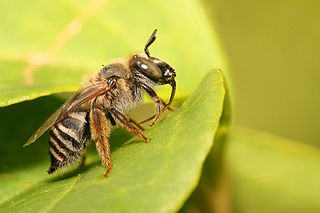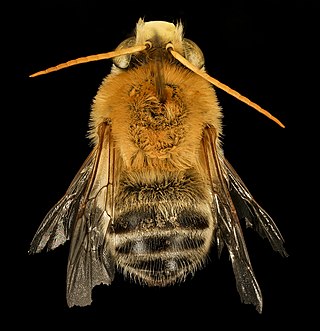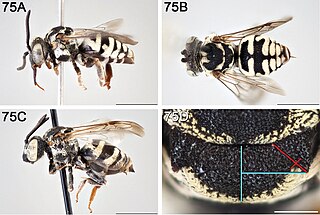
Hoplitis is a genus of bees in the family Megachilidae. There are more than 380 described species in Hoplitis.

Tetraloniella is a genus of long-horned bees in the family Apidae. There are more than 100 described species in Tetraloniella with most being from North America
Sphecodosoma is a genus of sweat bees in the family Halictidae. There are at least three described species in Sphecodosoma.

Martinapis is a genus of long-horned bees in the family Apidae. There are at least three described species in Martinapis.

Xenoglossa is a genus of large squash bees in the family Apidae. There are about 11 described species in Xenoglossa.

Epeolus carolinus is a species of cuckoo bee in the family Apidae. It is found in North America.
Oreopasites is a genus of cuckoo bees in the family Apidae. There are about 11 described species in Oreopasites.

Florilegus condignus is a species of long-horned bee in the family Apidae. It is found in the Caribbean Sea, Central America, and North America. It is an uncommon species in general but may be locally common near wetlands containing pickerelweed. It is often mistaken for species of the genus Melissodes.

Florilegus is a genus of long-horned bees in the family Apidae. There are about 14 described species in Florilegus.

Protoxaea is a genus of bees in the family Andrenidae. There are at least three described species in Protoxaea.

Epeolus glabratus is a species of cuckoo bee in the family Apidae. It is found in North America.

Ancylandrena is a genus of mining bees in the family Andrenidae. There are about five described species in Ancylandrena.

Epeolus olympiellus is a species of cuckoo bee in the family Apidae. It is found in North America.
Simanthedon is a genus of long-horned bees in the family Apidae, containing a single described species, Simanthedon linsleyi.

Epeolus autumnalis, the cuckoo bee, is a species of cuckoo bee in the family Apidae. It is found in North America.

The two-spotted miner bee is a species of miner bee in the family Andrenidae. It is found in Central America and North America. Members of the species have communal nests made of many cells. They live in desert scrub habitat. Their primary host plants belong to the genus Helianthus.
Triepeolus grindeliae is a species of cuckoo bee in the family Apidae. It is found in North America.
Micralictoides is a genus of sweat bees in the family Halictidae. There are about eight described species in Micralictoides.

Epeolus bifasciatus is a species of cuckoo bee in the family Apidae. It is found in Central America and North America. It is a parasite of Colletes latitarsis.

Paranomada is a genus of cuckoo bees in the family Apidae. There are at least three described species in Paranomada.














